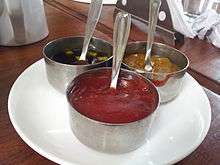Colo-colo (condiment)
Colo-colo is a type of hot and spicy condiment commonly found in Maluku archipelago, Indonesia. It is believed to have originated in Ambon city. Colo-colo is similar to Manado's dabu-dabu, as they both use many chopped red chili peppers, bird's eye chili, shallots, red and green tomatoes, and a pinch of salt and sugar, mixed with fresh calamansi juice or locally known as lemon cui or jeruk kesturi. (sometimes replaced by kaffir lime or lemon juice). The main difference is that colo-colo recipe often includes additional ingredients, such as chopped lemon basil, kenari nut, and tahi minyak or ampas minyak (black-colored cooking coconut oil residue), or caramelized rarobang (watery residue of coconut oil-making process).[1] As the result, colo-colo is darker and more oily than dabu-dabu.
However, today, because of the rarity and difficulty to acquire traditional cooking oil residue and caramelized rarobang, this oily agent is often replaced by widely available and practical kecap manis (sweet soy sauce) mixed with margarine, coconut oil or cooking oil. As z result, today colo-colo is often mistaken for another Indonesian common condiment, sambal kecap.
Maluku archipelago is famous for its rich collection of seafoods, and colo-colo is usually served as condiment for seafood, especially various recipes of ikan bakar (grilled fish) and ikan goreng (fried fish). Popular grilled seafood such as kakap merah (red snapper), baronang (rabbitfish), cakalang (skipjack tuna), cumi-cumi (squid) and udang (shrimp) are served with colo-colo as coating or dipping sauce. Colo-colo is often described as Ambon's sambal.
References
- "Colo-colo dan Dabu-dabu" (in Indonesian). Kompas.com. November 20, 2009. Retrieved April 3, 2014.
